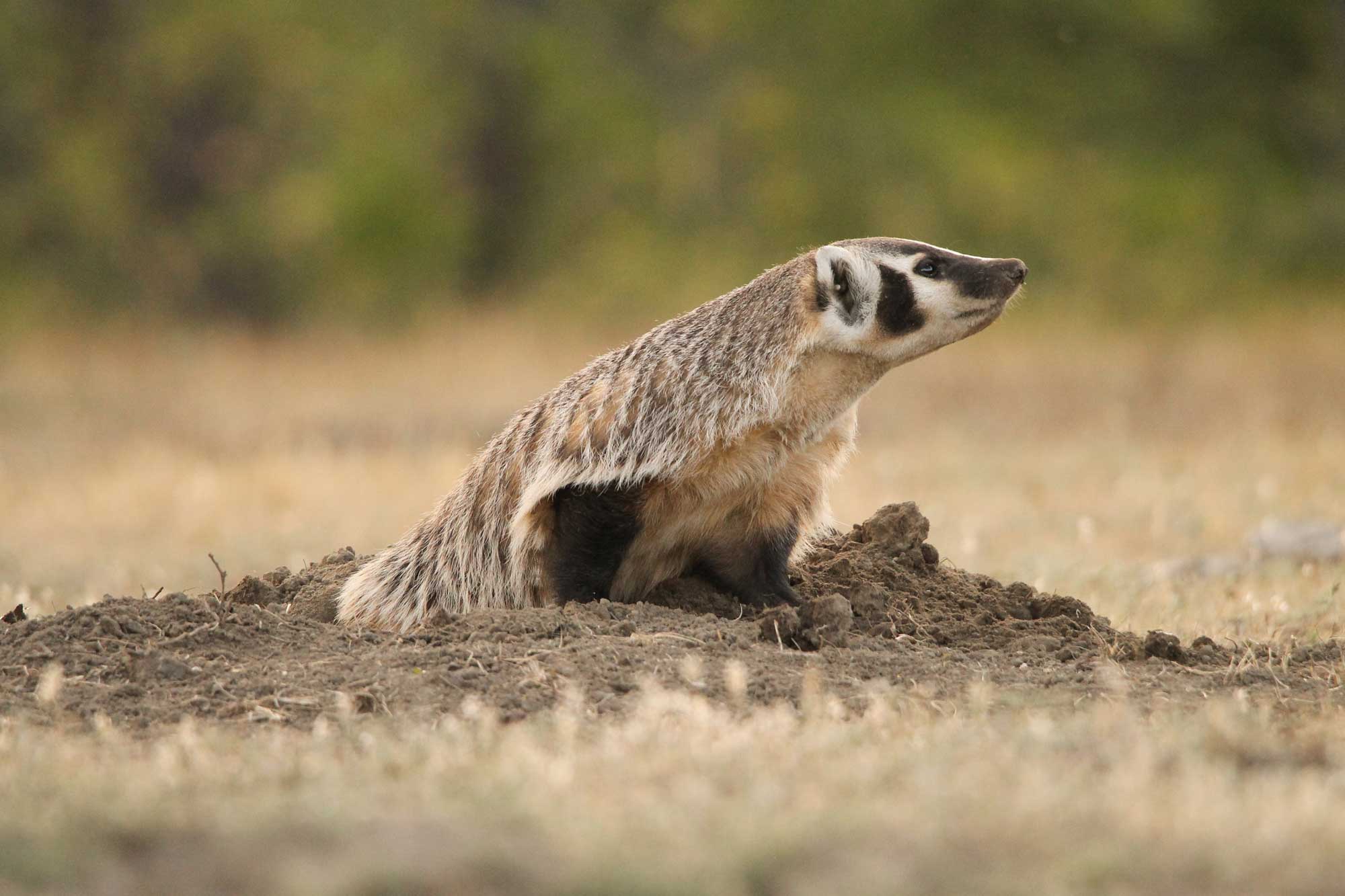Five fast facts about fast-digging American badgers

American badgers are easy to identify thanks to the bold striped appearance of their faces, but you may never get a chance to see one of these creatures in the wild for a few reasons.
For starters, these badgers are mostly nocturnal. They also live alone, and they spend a lot of time underground, according to Wildlife Illinois. In Illinois, they are mainly found in the northern two-thirds of the state, preferring open areas such as prairies, pastures and fields.
American badgers are part of the Mustelidae family of mammals, and they are related to weasels, otters, minks, wolverines, fishers and polecats, among others. They are one of a few badger species in the world. Others include the honey badger, which is native to parts of Africa and Asia; the hog badger, which lives in parts of Asia; and the European or Eurasian badger, which can be found in parts of Europe and Asia.
They are big diggers
If there is one thing to know about American badgers, it's that their digging skills are top notch. In fact, their digging skills are so good that they have been known to dig through concrete and asphalt. If you take a good look at a badger, many of the physical features you notice help them excel at digging. Their bodies are low to the ground, and they have strong shoulders, thick necks and small heads suited for burrowing into the ground, according to the Maryland Zoo.
Their feet are also specialized for digging. Their front feet have long, curved claws that help scoop dirt, and their back feet have short claws that work like shovels, the zoo reports. Even their eyes have a special adaptation that helps in their digging lifestyle. They have a specialized eyelid called a nictitating membrane that covers their eye to prevent dirt and dust from irritating them. Other animals that have this membrane include raptors like hawks, owls and eagles; sharks; polar bears; and hippos.
Badgers' digging prowess helps them in a few ways. First, they tunnel into the ground to hunt for prey. They also dig out the burrows where they sleep and rest. They can create dens with many feet of tunnels, and those dens will include sleeping chambers, according to Animal Diversity Web. They will often have several burrows spread across their home range, and they may use different sleeping chambers from day to day.
They have an excellent sense of smell
An excellent sense of smell might not seem necessary for animals that spend so much time underground, but American badgers have a keen sense of smell — second only to members of the dog family, according to Texas Parks & Wildlife. These badgers also see and hear well.
Their keen senses help them survive in the world and also aid in hunting. American badgers are mostly carnivorous, although they do occasionally eat plant-based foods such as corn, berries and sunflower seeds, according to Animal Diversity Web. In Illinois, their main food sources are other burrowing mammals, including pocket gophers, woodchucks and ground squirrels. Because they can dig faster than other burrowing animals, they are easily able to hunt for other subterranean creatures. They also eat mice, rabbits, moles and voles, as well as birds, snakes, frogs, and bird and snake eggs.
They are loners
Many of our local mammals are solitary animals, and American badgers are included in this group. They live alone except for the brief period when males and females come together to mate and when the females are raising their offspring, according to Wildlife Illinois. Badgers live in burrows that they dig into the ground. Some badgers will have more than one burrow, but they don't share burrows with other badgers except for when females are raising their young.
Young badgers, called cubs, only stay with their mothers for a few months after they are born. Mating occurs in late summer, and cubs are usually born in April or May, Wildlife Illinois reports. A litter typically includes two or three cubs, and they will stay in their den for the first several weeks of their life. After about a month, they begin taking short trips out of their den. By the time they are 3 months old, they have been weaned, and by the end of summer they have left their mother to establish their own territory and establish their own homes and ranges.
They sometimes hunt together with coyotes
Badgers really are solitary creatures, but they do sometimes make exceptions to their solitary lifestyle and buddy up with coyotes to hunt together. This duo may seem like an unusual pairing, but hunting together benefits them both because each has skills the others lack. Coyotes bring speed to the equation, and for the badgers it's their digging skills.
When working in tandem, coyotes and badgers often hunt animals like ground squirrels and prairie dogs, according to the U.S. Fish and Wildlife Service. The coyotes are fast enough to chase after these animals, but coyotes can't catch them in their underground tunnels and burrows. That's where the badger comes in. If potential prey escapes the coyote by seeking shelter underground, the badger can dig into the ground to catch it.
Although they are known to work together on a hunt, the coyotes and badgers don't share their prey, Treehugger reports. Sometimes the coyote will catch the animal as it attempts to escape on land, and other times the badger gets the catch when it digs underground to find it as it tries to escape. Even though the coyote and badger don't mutually benefit from each catch, it is still advantageous for them to hunt together sometimes.
They spend most of the winter asleep, but they don't hibernate
Animals have many different strategies for surviving winter, but only a few, like groundhogs, are true hibernators that spend months asleep underground. American badgers are among the many animals that don't hibernate, but they aren't always out and about in winter either. They are among of group of animals that go into a state of torpor in winter, according to the Maryland Zoo.
Torpor is similar to hibernation in that animals have a lower heart rate, breathing rate, metabolic rate and temperature, which helps them conserve energy. However, unlike hibernation, entering torpor is not voluntary. Animals go into torpor when conditions would make it difficult for the animals to be active, Treehugger reports. The other major difference between torpor and hibernation is duration. Animals hibernate for months at a time, but torpor can last just a few hours or a few days if necessary. In between periods of torpor, the animals are awake and their physiological rates return to normal.
During winter, badgers will stay in their underground burrows on cold days, entering torpor when conditions require it. On warm, sunny days, they may come out of their burrows to bask in the sun. Because food is more scarce and they aren't able to spend as much time hunting, badgers spend the summer and fall months eating extra so they can add more body fat to help them survive until the ground thaws out come spring, the Maryland Zoo reports.
